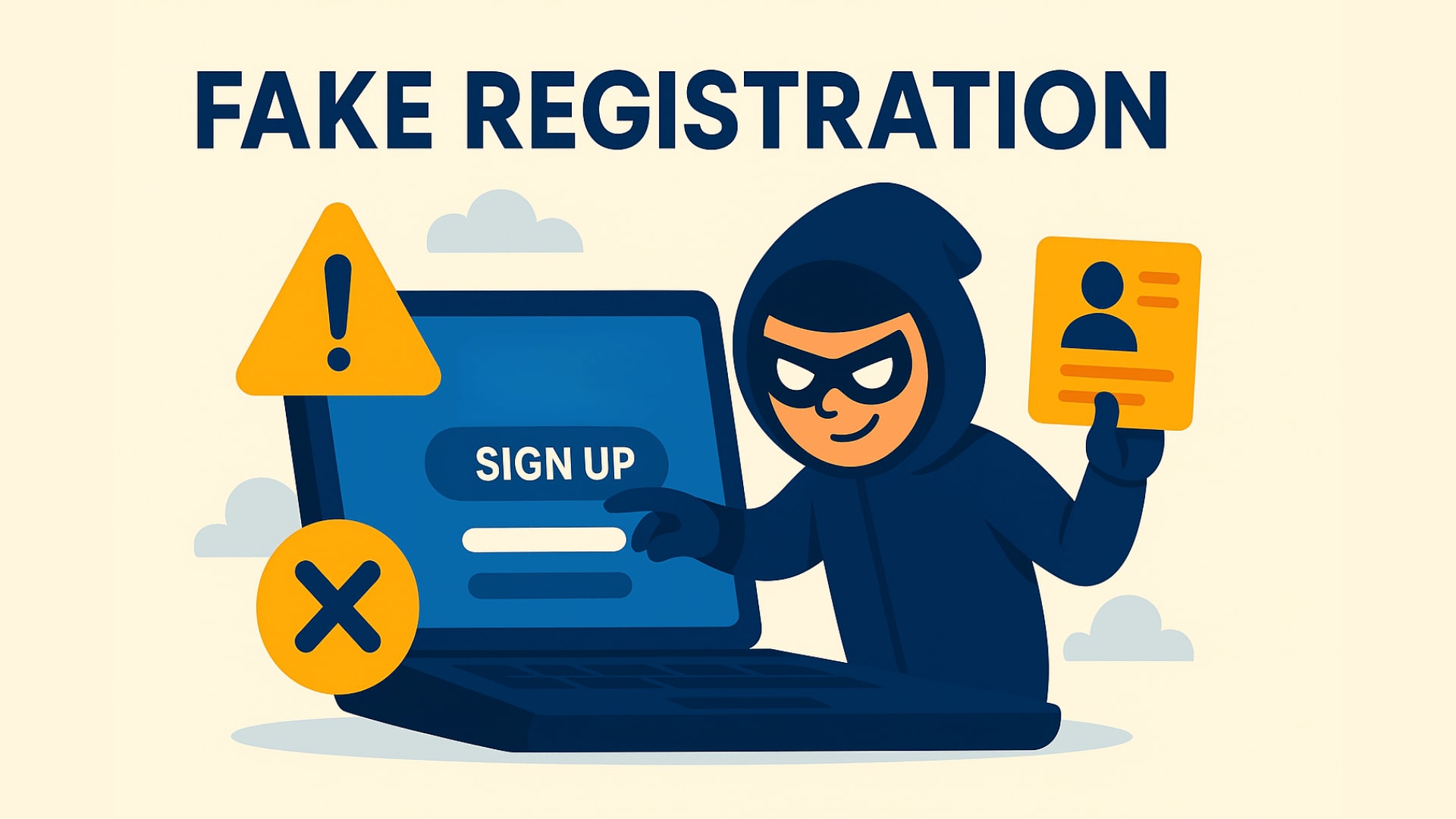
Every minute, thousands of fake accounts infiltrate digital platforms worldwide. What might look like healthy user growth often masks a more costly reality: fraudulent registrations that drain resources, corrupt data and erode user trust. In 2024 alone, fake account fraud cost businesses an estimated $2.7 billion globally. Yet many organizations still underestimate the threat lurking in their sign-up forms.
This article unpacks what fake registrations are, why they exist, how they’re detected and what businesses can do to stop them.
Table of contents
What Is a Fake Registration?
A fake registration or fake sign-up is the creation of a fraudulent user account on a digital platform. These accounts are typically made using fabricated or stolen personal data, disposable email addresses and often no intention to use the service legitimately. Unlike real users who register to participate in services, fake accounts exist purely for exploitation, manipulation, or fraud.
These fake sign-ups are commonly generated in large numbers by bots — automated scripts programmed to fill out registration forms in seconds. Some use sophisticated techniques such as rotating proxy servers, mimicking human behavior, or employing human solving services to bypass traditional defenses. More advanced bots can simulate human-like mouse movements, typing rhythms and interaction patterns to fool behavioral analytics systems.
Why Fake Accounts Are Created
Understanding the motives behind fake registrations helps clarify how widespread and varied the issue truly is. Cybercriminals create fake accounts to exploit systems for monetary gain, access, or disruption. One of the most common uses is spamming. Fake accounts can be programmed to spread links, junk content and malicious messages across forums, community platforms, or customer messaging tools.
They are also used to manipulate online contests or referral programs by flooding the system with multiple entries. This can lead to skewed results and eroded trust among genuine users. In more damaging use cases, fake registrations serve as entry points for phishing campaigns or credential stuffing attacks. By appearing legitimate, these accounts can bypass surface-level filters and gather information or compromise systems internally.
For subscription-based or metered services, bots often create multiple fake accounts to bypass trial limits or gain ongoing access without payment. Criminal groups may also create false identities to build credibility for long-term scams or targeted social engineering. The underground economy of fake accounts is robust, with services offering pre-aged or custom profiles for as little as a few cents.
How Fake Registrations Are Detected
Detecting fake sign-ups is no small feat. It requires multiple layers of defense that look beyond surface-level checks. Email analysis often provides the first filter. Disposable email domains like mailinator.com or 10minutemail.com, pattern-based emails (e.g., user001@example.com, user002@example.com) and addresses with invalid DNS or MX records are clear warning signs.
IP analysis is another key tactic. A sudden spike of sign-ups from a single IP address or subnet may indicate automation. Cross-referencing IPs with known proxy lists, VPNs, or TOR exit nodes can help identify high-risk connections. Device fingerprinting adds another layer by detecting patterns in browser configuration, screen resolution, language settings and plugin availability. Consistent fingerprints across multiple registrations can uncover bot activity.
Behavioral analytics are crucial in identifying automation. Human users interact with websites in slightly unpredictable ways — mouse movements are erratic, typing speeds vary and sessions differ in length. Bots, on the other hand, often complete forms at unrealistic speeds, move in straight lines and exhibit highly uniform behavior. Systems that monitor for these discrepancies are more successful at flagging fake accounts in real time.
While effective, these methods come with trade-offs. Some require data processing or tracking, which raises privacy concerns and necessitates compliance with regulations like GDPR. That’s why businesses increasingly seek privacy-first technologies to detect fraud without compromising user trust.
Hidden Costs of Fake Registrations
Fake registrations don’t just waste time — they create measurable financial damage. Hosting and maintaining fake accounts consumes server resources and adds unnecessary load to databases. Support teams often spend time resolving issues tied to fake users — like moderating spam, responding to abuse reports, or chasing fraud-related bugs.
From a business strategy perspective, fake accounts pollute analytics. Metrics like active users, click-through rates, or conversion funnels become unreliable, leading teams to misallocate resources or invest in the wrong growth strategies. In worst-case scenarios, product decisions or investor reports based on flawed data can create long-term reputational and financial risks.
There’s also a marketing cost. Ad budgets are wasted on audiences that don’t exist. Email campaigns sent to fake accounts can damage sender reputation and increase bounce rates. Paid user acquisition campaigns may show impressive sign-up rates—but no retention, engagement, or conversion. The illusion of growth hides the absence of genuine value.
Security-wise, fake accounts create a false sense of activity while serving as launchpads for abuse. They often act as the first step in broader infiltration strategies — from phishing attempts to privilege escalation or credential testing.
Building an Effective Defense Strategy
The best approach to stopping fake registrations is a layered one. Start with advanced CAPTCHA protection. Modern CAPTCHA systems — like those offered by captcha.eu — use cryptographic proof-of-work to make bot registration computationally expensive. Unlike older image- or audio-based CAPTCHAs that frustrate users, captcha.eu focuses on an accessible, privacy-friendly experience.
Add email and phone verification to introduce cost and effort into the process of creating fake accounts. Social login can also be effective, as it leverages fraud detection systems of platforms like Google or Facebook. However, these methods must still respect user privacy and offer alternatives for those unwilling to link third-party accounts.
Rate limiting can be used to control how many sign-ups a single IP address can attempt over time. Add exponential backoff to slow down repeated attempts and use geo-blocking during high-risk campaigns. Honeypot fields — hidden form fields only bots will fill — can catch low-level automation without affecting user experience.
Progressive profiling offers a smart balance between friction and protection. Ask only for minimal information at first and introduce further verification steps (like phone confirmation or identity checks) as users attempt to access more sensitive features. This lets you screen users gradually without turning away genuine sign-ups at the door.
Use real-time scoring models that assess the risk of a registration attempt by analyzing data points like device characteristics, session speed, referral source and email legitimacy. Combine these insights to dynamically apply stricter controls where needed.
Prevention and Ethical Considerations
Effective fake registration prevention is not a one-time fix — it’s an ongoing process. Monitor performance regularly. Track false positive rates, user complaints and bounce patterns to ensure legitimate users aren’t being blocked or discouraged. Update detection rules as attackers evolve.
Maintain GDPR compliance by minimizing personal data collection, being transparent with users and implementing privacy-by-design principles in your technology stack. Accessibility should also be top of mind. Security shouldn’t come at the cost of excluding users with disabilities. Ensure WCAG 2.2 AA compliance and offer alternative verification methods where needed.
Finally, balance rigor with empathy. No fraud detection system is perfect, so it’s critical to offer an appeals process and responsive support for users who are mistakenly flagged.
Conclusion
Fake registrations may seem like background noise, but their long-term impact is loud and costly. They waste resources, distort growth metrics, increase fraud risks and undermine user trust. What starts as a simple form submission can quickly become a gateway to large-scale abuse.
By taking a proactive, privacy-conscious and user-friendly approach to fraud prevention — with layered strategies and technologies like captcha.eu — organizations can fight back effectively. Clean user data, improved campaign performance and stronger community trust are just a few of the benefits of keeping fake accounts out.
The first step to protecting your platform isn’t your firewall — it’s your registration form.
FAQ – Frequently Asked Questions
What is a fake registration?
A fake registration is the creation of a user account using false, stolen, or temporary information—usually by bots or malicious actors. These accounts are not created for genuine use but to exploit systems, commit fraud, or spread spam.
Why do bots create fake sign-ups?
Bots create fake sign-ups to bypass free trial limits, flood contests with entries, conduct spam campaigns, harvest data, or stage phishing attacks. They can be part of larger fraud schemes that aim to manipulate analytics, drain resources, or launch cyberattacks.
How can you tell if a registration is fake?
Signs of fake registration include disposable or pattern-based email addresses, multiple sign-ups from the same IP address, unnaturally fast form completions, identical device fingerprints, and suspicious user behavior patterns like no profile activity or immediate abandonment.
How can I prevent fake registrations on my website?
Use a layered defense strategy: implement advanced CAPTCHA solutions like captcha.eu, verify emails or phone numbers, monitor IP and behavior patterns, use rate limiting, and consider progressive profiling. These steps help block bots while preserving user experience.
Is it possible to block all fake registrations?
It’s nearly impossible to eliminate all fake registrations, but you can dramatically reduce them with the right mix of tools, data monitoring, and user verification processes. Continuous updates and a privacy-first approach are key to staying ahead of attackers.
100 free requests
You have the opportunity to test and try our product with 100 free requests.
If you have any questions
Contact us
Our support team is available to assist you.




